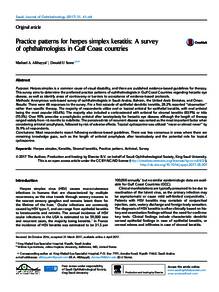Document
Practice patterns for herpes simplex keratitis : a survey of ophthalmologists in Gulf coast countries.
Identifier
DOI: 10.1016/j.sjopt.2017.03.007
Source
Saudi Journal of Ophthalmology. v. 31, 2, p. 61-64
Contributors
Stone, Donald U., Author
Country
Netherlands.
Publisher
Elsevier B.V.
Gregorian
2017-04-01
Language
English
Subject
English abstract
Purpose Herpes simplex is a common cause of visual disability, and there are published evidence-based guidelines for therapy. This survey aims to determine the preferred practice patterns of ophthalmologists in Gulf Coast Countries regarding herpetic eye disease, as well as identify areas of controversy or barriers to acceptance of evidence-based protocols. Methods Anonymous web-based survey of ophthalmologists in Saudi Arabia, Bahrain, the United Arab Emirates, and Oman. Results There were 48 responses to the survey. For a first episode of epithelial dendritic keratitis, 28.2% reported “observation” rather than specific therapy. The majority of respondents utilize oral or topical antiviral for epithelial keratitis, with oral antiviral being the most popular (43.6%). The majority also included a corticosteroid with antiviral for stromal keratitis (83.9%) or iritis (70.3%). Over 90% prescribe a prophylactic antiviral after keratoplasty for herpetic eye disease, although the length of therapy ranged widely from 6 months to indefinite. The perceived risk of recurrent disease was ranked as the most important factor when considering antiviral prophylaxis, followed by risk of adverse effects. Topical cyclosporine was utilized “never or almost never” by 76.9% of respondents. Conclusions Most respondents report following evidence-based guidelines. There was less consensus in areas where there are remaining knowledge gaps, such as the length of antiviral prophylaxis after keratoplasty and the potential role for topical cyclosporine.
ISSN
1319-4534
Category
Journal articles

